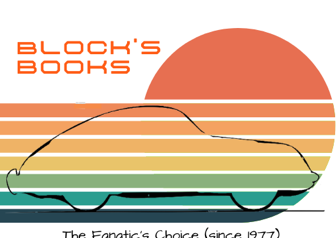
From my reviews in the 356 Registry:
The big surprise of the year is Jerry Pantis’ Porsche 904, 906 & 910 in the Americas. As with each of the previous 904 books – Jurgen Barth’s Porsche 904 and Phillip Olczyk’s Porsche 904 Truth & Rumours, Porsche 904, 906 & 910 in the Americas is a large book (432 pages). It follows the general layout of the two preceding books by providing an historical background – in this case, Part I focusing on the drivers and racing dealers, followed by a racing history, in turn followed by individual car histories. Even though I was a young enthusiast at the time and avidly read Road & Track and Sports Car Graphic, I did not appreciate the interplay between Zipper with initially Ken Miles, then Scooter Patrick driving and subsequently Vasick Pollack with Ken Miles and other drivers. I think the thesis that Scooter Patrick was the best two liter driver of the period is unassailable and that Don Wester was probably at least the equal of Miles also seems evident. Part II moves to the actual racing. At the time Porsche was doing extremely well in international racing, so I did not realize that the movement to CAN AM and its big money racing essentially destroyed two liter racing in the United States; with drivers who wanted to continue to race Porsches moving to 911s.
Pantis used two of the most knowledgeable Porsche scholars I know: Tim Kuser and Jim Perrin – though he identifies Jim as the PCA (not Registry) historian, but seems unaware Jim was President of the PCA. A large part of the book’s meat is the history of individual cars in the US – 906s & 910s as well as 904s. Part III, Individual Chassis Histories, demonstrates research clearly superior to that of either Barth or Olczyk – 904s with which I was personally acquainted are done correctly now. Previously missed is Porsche’s selling almost 20 repair chasses, primarily to Vasek Polak and Heinz Kurek. Olczyk claims that the 904s with serial numbers 904-010, 904-013, 904-062, 904-113, and 904-115 are recreations. I happen to have some familiarity with one of these cars. 904-013 was the Bob Hagestad car –– I lived in Denver at the time and remember the excitement of the car being flown from Germany to Denver – raced by Bob and sold to George Drolsom, who wrecked it. There is no disagreement that the car was sent to the factory, which sold George a replacement chassis 906-012 and returned his chassis plate. While Olczyk states that Kurek “bought some damaged parts and built a complete car,” Pantis points out that 904-013 -- with extensive front end damage -- was sold to Kurek, who in turn rebuilt it. “All the parts he needed were bought at Porsche.” In additional to the 904, the book covers 906, 906E and 910.
As chief hanger-on at Bill Randle’s Eichhorn Garage and Grady Clay’s Rennenhaus in the 60s and 70s, I was also familiar with 904-017 and know that Bill Randle acquired the car in California. I know Olczyk is incorrect in his claim that it was sold to Grady Clay then to Bill Randle. Bill, during his divorce, had sold the car via a lawyer to Grady, who kept it hidden in a box in his garage until Bill’s ex-wife was no longer around. I remember Grady showing me the car and pledging me to secrecy. Jerry Pantis now has the history recorded correctly, Olczyk refused to even discuss the possibility he had the order of ownership wrong when I contacted him.
Part IV, Racing in South America, reveals apparently extraordinarily wealthy owners racing the latest from Porsche against a very mixed group including Volkswagens. It also two inter-related explanations for chassis number confusion. Not only did race team routinely swap chassis serial numbers as a convenient way to get a car through customs, as the chassis which had already passed, but taxes could be saved if an owner only admitted to owning one car instead of two or several. Part IV addresses imported 904s.
The appendices are full of fascinating information, especially the first appendix listing replacement 904s. Never before has it been written that all of the factory six cylinder 904s (with by the way 906 serial numbers – starting with 906-001 vs. Carrera 6 serial numbers starting with 906-101) were sold sans engines. The second series 904s and 904/906s were similar and could be distinguished by roll up windows, big air intakes in place of fog lamps, center fill gas intakes. And there are seven appendices. Finally there is a chassis index with build dates, original motor and transmission numbers and colors and an owner, entrant & driver index – page keyed to the earlier chapters.
Sometimes charming, serendipitous things happen – I picked-up a box of Porsche 904, 906 & 910 in the Americas from Jerry at the LAX Toy & Lit meet. The next weekend I wandered in to Neil Goldberg’s Stuart Tool for the Saturday morning Bagel Club (aka for those truly without a life – I never miss it when I am in town), to be met by Alex Pollock, who with Neil’s help was reassembling 904-028 after having its paint returned to the original silver after 30 years of chalk white. You will perhaps not be surprised that I sold Alex a book.
Porsche 904, 906 & 910 in the Americas belongs in the shelf of every Porsche enthusiast.
return to 356 books


